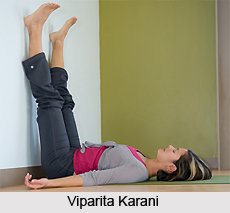 Viparita Karani or the inverted action is a cultural yoga asana wherein the whole body is inverted or made to stand upside-down. Viparita Karani steps up blood circulation to the head and is therapeutic for a wide range of illnesses.
Viparita Karani or the inverted action is a cultural yoga asana wherein the whole body is inverted or made to stand upside-down. Viparita Karani steps up blood circulation to the head and is therapeutic for a wide range of illnesses.
Meaning of Viparita Karani
In Sanskrit, `Viparita` means inverted and `Karani` means an action, and the asana derives its name from the posture that involves inverting the position of the body, placing the head at the bottom and the legs on top.
Yoga Texts and Viparita Karani
Viparita Karani was first described in the Hatha Yoga Pradipika though as a mudra and not as an asana. The text gives great prominence to the Viparita Karani as a mudra that will allow the practitioner to conquer death and recover youth. The text also advises yogis to eat more during the practice of this mudra, as it tends to increase one`s appetite. Asanas resembling the Viparita Karani mudra were recorded in the Shri Tattva Nidhi and other later Yoga manuals.
Practice of Viparita Karani
A sequential process for the practice of Viparita Karani follows:
* The student should first lie supine on his seat with all his muscles completely relaxed. Then he shall slowly raise his legs through the hip-joint till they make an angle of 30degree with the ground.
* Here the legs should be kept steady for a few seconds, and then raised through another 30degree Again they are kept steady here and again raised so as to complete a right angle. This is maintained for a few seconds.
* Upto now the student shall not bring into action his arms and elbows which play only a passive part.
* Next in his subsequent movements, he has to use his arms and elbows somewhat actively. After keeping his legs in a perpendicular position for a few seconds, the student raises his hips and curves up the trunk, keeping his legs in the same erect position that they have already assumed.
* The weight of the body is, thus, raised and supported by stiffening the arms that are still stretching along the ground.
* Here the trunk does not make a right angle with the ground as in Sarvangasana, but simply takes an upward curve.
* Then the forearms of the practitioner are bent through the elbows and the hands are made to support the curving frame at the hip-bones.
* The posterior part of the head, of the neck, of the shoulder-blades, and the arms up to the elbows are made to lie along the ground.
* The chest does not press against the chin, but keeps itself away from the chin.
* The eyes are either closed to concentrate the mind upon a particular part in the body or are kept fixed upon the toes.
* Then the student forms the Tongue-Lock and thus completes the Inverted Action.
Effects of Viparita Karani
Viparita Karani maintains the health of thyroid gland and is therapeutic for the gonads of either sex. For females, it alleviates the symptoms of ovarian disorders. Viparita Karani is also useful in dyspepsia, hernia and visceroptosis. It helps in effective blood circulation in the head and relieves tired or cramped legs and feet. Gently stretches the back legs, front torso, and the back of the neck. Relieves mild backache and calms the mind.
Precautions in practice of Viparita Karani
The Yogic texts state that the practice should begin with twenty-four seconds on the first day, adding a few seconds every day to the tenure of the asana. The maximum time recommended for Viparita Karani is three hours. For an exclusive practice of Viparita Karani in the case of a man of average health, it is recommended being twenty-four minutes as the maximum. But if this Inverted Action is to be done along with other exercises, this singular pose time should be reduced to six minutes only. The points of dissimilarity between the technique of Viparita Karani and that of Sarvangasana should be carefully noted and observed while practice.




















